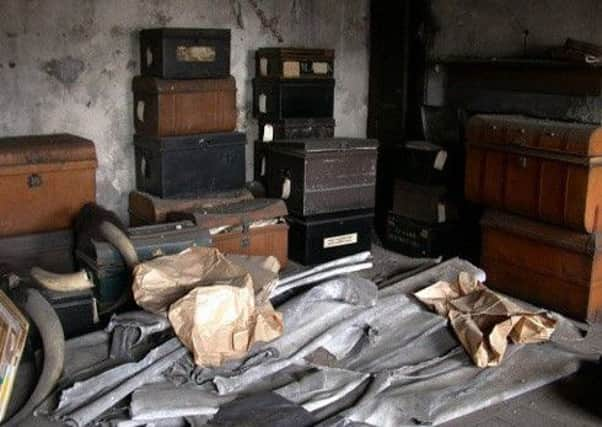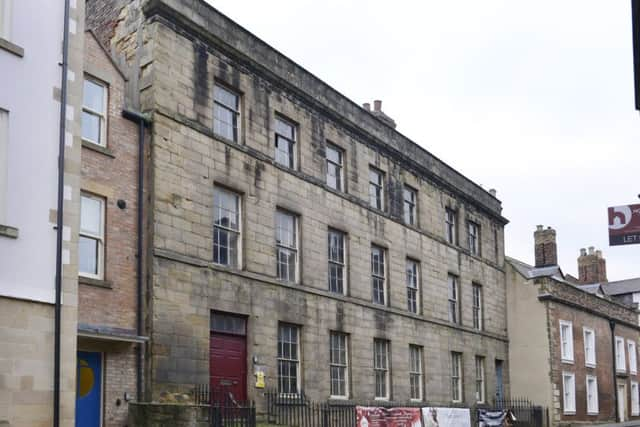Tales of scandal hidden within historic Alnwick building


They are true tales that resonate with today’s society, but equally have a place firmly in history.
For 200 years, the currently disused former General Lambert’s House in Narrowgate, was home to legal practice Dickson, Archer & Thorp and the collection of documents they left is rich in social, political and economic detail, uncovering many forgotten local stories.


Advertisement
Hide AdAdvertisement
Hide AdNow, it has let up some of its secrets that are being revealed in an exhibition, at the Bailiffgate Museum, just a few paces away, which runs until Sunday, January 20.
The story of the scandalous Beresford Lisle, son of a prominent, wealthy family drunkenly abducting two Alnwick girls in 1907 and taking one against her will to Belgium.
Tales of petty thieves transported to Australia in 1831: George Turnbull for 14 years for the theft of a ‘great coat’ and John Fletcher for seven years for stealing 5lbs of mutton.
The site has medieval origins, set on a burgage plot which marked landownership at the time.
Advertisement
Hide AdAdvertisement
Hide AdThe house was turned into two homes in the 18th century. It is thought this work may have been ordered by General Lambert, who stayed there while presiding over courts known as the Northumberland Quarter Sessions.
For the next 30 years, the property was in residential use before being sold to solicitors Dickson, Archer and Thorp, who remained in the property for two centuries, until the last surviving partner, Reginald William Tudor Thorp, died in 2003, aged 87. He was born in 1915 and joined the practice in 1945.
Much of the three-storey building and its basement were left untouched and many of the original fixtures and fittings remain.
The Thorp family put many of the contents under the hammer in April 2005.
Advertisement
Hide AdAdvertisement
Hide AdReginald’s son Robert Thorp recalls visiting his father’s office in General Lambert’s House: “It was such a large building with plenty of dry storage rooms upstairs where so many of the old documents were kept.
“I remember hearing that some documents were recycled during the Second World War but apart from that, very little was destroyed.
“I always felt like I was stepping back to Dickensian time when visiting my father at his firm.”
In 2015, Northumberland Archives was approached and asked if it would be interested in purchasing the remaining Dickson, Archer and Thorp collection – more than 400 archive boxes of documents – for £150,000.
Advertisement
Hide AdAdvertisement
Hide AdIn light of its historic and cultural significance, the sum was declared reasonable and the decision to proceed with the purchase was made.
Items within the collection can be dated beyond the practice’s establishment in the 18th century right through to the death of Mr Thorp.
It is the only legal collection in the care of Northumberland Archives to have this level of historical volume and scope.
The practice had a wide client base dealing with probate cases of families of relatively modest means to dealing with the business of many county families and the Duke of Northumberland and the involvement of practice partners in the governance of the county and more locally.
Advertisement
Hide AdAdvertisement
Hide AdThe eventual acquisition was made possible through internal fund-raising, as well as grants and charitable funding from a range of grant-giving bodies, including the Heritage Lottery Fund.
The acquisition was formalised in 2017, with a week set aside for archival staff to box and roughly list this immense collection.
Finally, the collection’s journey had brought it to be stored forever by Northumberland Archives, allowing it to be seen by all members of the public.
Jane Mann, a Bailiffgate Museum volunteer, said: “Each time I walk to the museum I have passed by General Lambert’s Townhouse, wondering what went on behind those dusty windows.
Advertisement
Hide AdAdvertisement
Hide Ad“When I first moved to Alnwick in 1996, the lights were still on and we saw people at work.
“Fascinating that so many years on, the museum has been able to tell the tale of this building and the firm of solicitors who worked there for so long.
“I know many local people have been equally intrigued.”
Stablewood Leisure, which runs the Apple Inn at Lucker and has 26 luxury coastal cottage, acquired the building in 2014 and now has planning permission and Listed Building Consent to convert it into five luxury serviced apartments and a French-style patisserie in the basement.
Here a some of the stories that have emerged:
ALNWICK ABDUCTIONS AND OTHER STORIES
One of the stories featured in the exhibition of the collection from solicitors Dickson, Archer and Thorp involved the abduction of two girls from Alnwick.
Advertisement
Hide AdAdvertisement
Hide AdIt is retold in a scrapbook of newspaper cuttings of the crimes.
In the summer of 1907, Louisa Rose Whittle, 15, and Theresa Roper, 17, were walking through Alnwick when William Beresford Orde Lisle, a dashing and affluent 21-year-old, asked if they would ‘like to ride in his motor car’.
The girls agreed to a short motor ride but William spirited them away to Durham, Darlington and York.
Three days after leaving Alnwick, William exclaimed: “You are seeing life, you must see London too.”
Advertisement
Hide AdAdvertisement
Hide AdThe girls repeatedly asked to be returned home but William refused, essentially holding them hostage.
Once in London, William ‘experienced a fit of rage and destroyed the girls’ bonnets’.
The next day, ashamed of his behaviour, he bought the girls new hats. William soon ‘sickened of Louisa’ and put her on a train to Newcastle.
Theresa and William then went to Dover, where he told her they could ‘board a boat for Alnwick’.
Advertisement
Hide AdAdvertisement
Hide AdThe boat actually took the couple to Brussels, where he proceeded to extract £400 and drink heavily.
In Ostend, he tried to persuade Theresa to share her room with him. When she rebuffed his advances, ‘he fired his revolver in a public house, scattering the patrons’.
Frightened by his behaviour and having never been away from her Northumbrian home, Theresa plotted her escape. She eventually found her way to the British Vice-Consul who sent her home, ‘where she remained in bed for three weeks’.
On his return, William was sued by the families of the traumatised girls. The trial became a national scandal and William was made to compensate his victims.
TROUBLE AT THE ANGEL INN
Advertisement
Hide AdAdvertisement
Hide AdIn 1875, a great number of agricultural labourers and pitmen from surrounding collieries descended upon Alnwick for the annual March hirings.
During the hiring, two brothers, John and Thomas Waite, were drinking heavily at the Angel Inn. John’s drunken behaviour became ‘so violent that Mr White, the landlord, sent for the police to put him out’.
Two constables arrived to eject John from the Inn, but their way was barred by a heavily intoxicated crowd numbering almost 2,000. The crowd jostled with the police and John Waite escaped.
During the skirmish, Sergeant Hately was pushed and grabbed by the angry crowd. He tried to defend himself but ‘fell, ashen-faced, to the ground’.
Advertisement
Hide AdAdvertisement
Hide AdThe constables rushed forward to assist but the jeering crowd kicked them away.
Eventually, the constables were able to carry Hately back to the police station. Medical assistance was called but Hately was declared dead, leaving a widow and eight young children. A post-mortem found evidence of a heart attack.
The Waites, along with six others, were charged with assaulting PCs Robinson and Connell and were fined the sum of £10.
VICTORY IN COURT FOR CRASTER’S FISHING COMMUNITY
One story uncovered is that of how four local fisherman stood together against paying a landlowner to bring their boats up on shore at Craster.
Advertisement
Hide AdAdvertisement
Hide AdIn 1844, fishermen were being charged 32 shillings per year plus an ‘acknowledgement’ of ‘six haddock fish and one lobster’ for the use of Craster Haven.
Four fishermen refused to pay, arguing that under common law and by custom, anyone, not only fishermen, had the right to cross over Mr Craster’s land to access the cove and thereafter the sea.
Thomas Wood Craster decided to make an example of one of the fishermen, John Archbold, and issued a writ against him.
He was tried in front of a judge and jury in Northumberland in 1854.
Advertisement
Hide AdAdvertisement
Hide AdJohn lost the case but he appealed to the Court of Queen’s Bench, London, in 1855, and three senior judges found in John’s favour.
The monopoly was broken and the fishermen of Craster no longer had to pay an annual fee or provide free haddock and lobster to the landowner and his family.